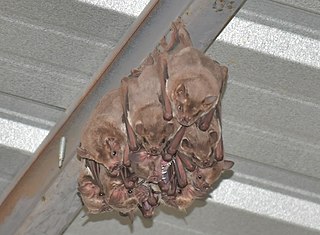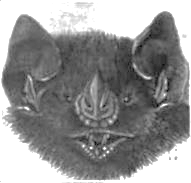
The New World leaf-nosed bats (Phyllostomidae) are found from southern North America to South America, specifically from the Southwest United States to northern Argentina. They are ecologically the most varied and diverse family within the order Chiroptera. Most species are insectivorous, but the phyllostomid bats include within their number true predatory species and frugivores. For example, the spectral bat, the largest bat in the Americas, eats vertebrate prey, including small, dove-sized birds. Members of this family have evolved to use food groups such as fruit, nectar, pollen, insects, frogs, other bats, and small vertebrates, and in the case of the vampire bats, even blood.

The white-winged vampire bat, a species of vampire bat, is the only member of the genus Diaemus. They are found from Mexico to northern Argentina and are present on the islands of Trinidad and Margarita.

The Jamaican, common or Mexican fruit bat is a fruit-eating bat native to the Neotropics. The distinctive features of the Jamaican fruit bat include the absence of an external tail and a minimal, U-shaped interfemoral membrane.

Andersen's fruit-eating bat is a bat species found in South America.

The white-throated round-eared bat is a bat species found from Honduras to Bolivia, Paraguay and Brazil. It creates roosts inside the nests of the termite, Nasutitermes corniger. It thrives on a mainly insect-based diet, focusing on the surfaces of foliage to hunt, and also eats fruit and pollen. It has a very wide range and is a common species over much of that range, so the International Union for Conservation of Nature has assessed its conservation status as being of "least concern".

Glossophaga is a genus of bats in the leaf-nosed bat family, Phyllostomidae. Members of the genus are native to the American Neotropics.

The fraternal fruit-eating bat is a species of bat in the family Phyllostomidae that is found in drier habitats in Ecuador and Peru. It was formerly considered to be a subspecies of the Jamaican fruit bat, but was raised to species level in 1978. The smallest species in the group of large Artibeus, it has a forearm length of 52–59 mm (2.0–2.3 in), a total length of 64–76 mm (2.5–3.0 in), and a weight of 30–55 g (1.1–1.9 oz).

The Honduran fruit-eating bat is a species of bat in the family Phyllostomidae. It is found in El Salvador, Honduras, and Nicaragua.

The flat-faced fruit-eating bat is a South American species of bat in the family Phyllostomidae. It is sometimes considered a subspecies of the Jamaican fruit bat, but can be distinguished by its larger size, the presence of faint stripes on the face, and of a third molar tooth on each side of the upper jaw. Genetic analysis has also shown that the two species may not be closely related.

The velvety fruit-eating bat, also known as Hart's little fruit bat, is a species of bat in the family Phyllostomidae. It is the only species within the genus Enchisthenes. It is found in Central America, Mexico, the United States, and northern South America.

Stenodermatinae is a large subfamily of bats in the family Phyllostomidae.

Thomas's fruit-eating bat, sometimes also popularly called Watson's fruit-eating bat, is a species of bat in the family Phyllostomidae. It is found from southern Mexico, through Central America to Colombia. Its South American range is to the west of the Andes. The species name is in honor of H. J. Watson, a plantation owner in western Panama who used to send specimens to the British Natural History Museum, where Oldfield Thomas would often describe them.
Dermanura rava is a species of leaf-nosed bat found in Central and South America.











